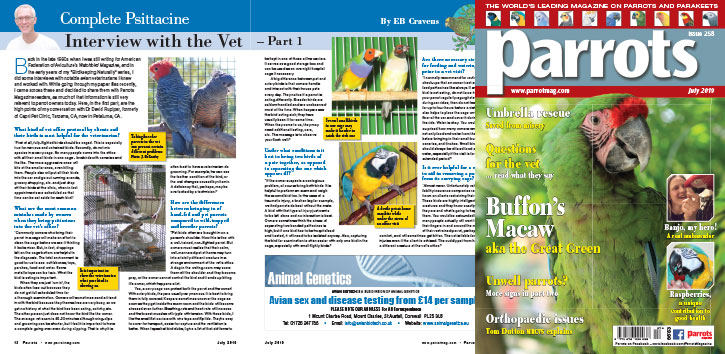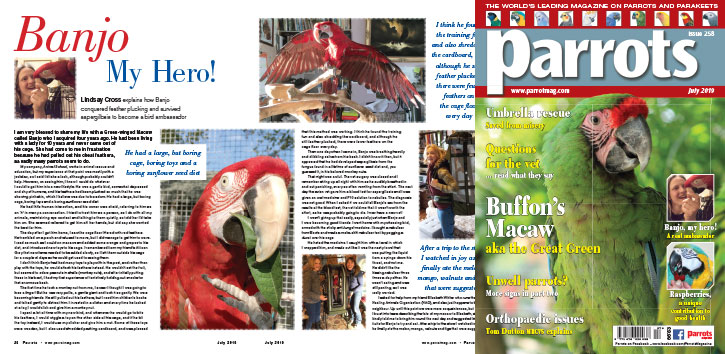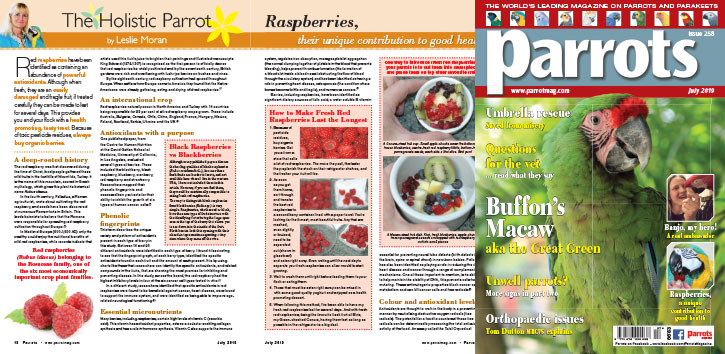
Complete Psittacine by Eb Cravens
Back in the late 1990s when I was still writing for American Federation of Aviculture’s Watchbird Magazine, and in the early years of my “Birdkeeping Naturally” series, I did some interviews with notable avian veterinarians I knew and worked with. While going through my paper files recently, I came across these and decided to share them with Parrots Magazine readers, as much of that information is still very relevant to parrot owners today. Here, in the first part, are the high points of my conversation with Dr David Rupiper, formerly of Capri Pet Clinic, Tarzana, CA, now in Petaluma, CA.
What kind of vet office protocol by clients and their birds is most helpful for the veterinarian?
“First of all, fully-flighted birds should be caged. This is especially true for nervous and untrained birds. Secondly, do not mix species in a carry cage. So many people come into the office with all their small birds in one cage - lovebirds with canaries and the like. The more aggressive ones will bite at the smaller ones, even killing them. People also will put all their birds into the car and go out running errands, grocery shopping, etc. and just drop off their birds at the clinic, when in fact appointments are scheduled so that time can be set aside for each bird.”
Buy Now!

Lindsay Cross explains how Banjo conquered feather plucking and survived aspergillosis to become a bird ambassador.
I am very blessed to share my life with a Green-winged Macaw called Banjo who I acquired four years ago. He had been living with a lady for 10 years and never came out of his cage. She had come to me in frustration because he had pulled out his chest feathers, as sadly many parrots seem to do.
My company, Animal School, works in animal rescue and education, but my experience at that point was mostly with a jackdaw, so I said I’d take a look, although probably couldn’t help. However, on seeing him, I knew I would do whatever I could to get him into a new lifestyle. He was a gentle bird, somewhat depressed and shy of humans, and his feathers had been plucked so much that he was showing pink skin, which I believe was due to boredom. He had a large, but boring cage, boring toys and a boring sunflower seed diet.
Buy Now!

Dr Roslynn Sinclair tells us how her interest and love grew for this most underrated and endangered species
The Buffon’s Macaw is the second largest macaw in the world, surpassed only by the Hyacinth Macaw, although some Buffon’s individuals may be larger, in weight and/or physical size, than some Hyacinth individuals. In colour, the Buffon’s does look quite a bit like the Military to the untrained eye, however it is in the eye that the most definitive distinction can be made.
Both species are basically green, the Buffon’s being more of a yellow green, with a bare white facial patch and small black feather lines, sometimes partly red, above a large dark grey beak and red feathers on the forehead. Scattered yellow feathers on the Buffon’s body are not uncommon. Scattered maroon (bronze) feathers are also not uncommon, but occasionally birds develop partially maroon feathers over much of their bodies, the reason for which is unknown, but sometimes the feathers revert back to green after a moult. The Military Macaw has a darker look over its body, darker green rather than yellow green, with red on tail feathers rather than red-orange, and is a lot smaller than the Buffon’s Macaw.
Buy Now!

The Holistic Parrot by Leslie Moran
Red raspberries have been identified as containing an abundance of powerful antioxidants. Although when fresh, they are an easily damaged and fragile fruit, if treated carefully they can be made to last for several days. This provides you and your flock with a health promoting, tasty treat. Because of toxic pesticide residues, always buy organic berries.
The red raspberry was first discovered during the time of Christ, local people gathered these wild fruits in the foothills of Mount Ida, Turkey. It is the name of this mountain, sacred in Greek mythology, which gives this plant its botanical name Rubus idaeus.
In the fourth century, Palladius, a Roman agriculturist, wrote about cultivating the red raspberry, and seeds have been discovered at numerous Roman forts in Britain. This leads botanists to believe that the Romans were responsible for spreading red raspberry cultivation throughout Europe.
Buy Now!




